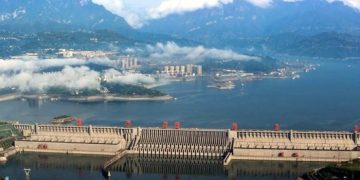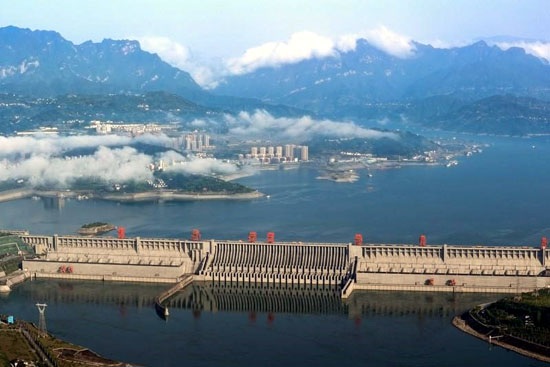Some of the most sophisticated 20thcentury technologies have been applied to build the largest hydroelectric dam in the world, the Three Gorges Dam Project (TGDP) of China.
In particular, technology is being challenged and stretched to the limit as never before to construct the Three Gorges Dam. Unprecedented production rates are becoming the norm in order to keep the sizable project on schedule, while adhering to the highest quality requirements of construction codes. After the completion of the project by 2009, the technology used in the construction of the dam will probably need to be reviewed and enhanced in light of lessons learned.
The TGDP is projected to become the world’s largest dam-nearly four times larger than Hoover Dam, with a height of 607 ft. (185 m) and a length of approximately 1.4 miles (2.3 km; Kosowatz, 1999). The TGDP is composed of the dam, two power plants, and the navigation facilities. The dam is composed of three sections: the spillway dam, the intake dam, and the non-overflow dam. The permanent navigation structures include a ship lock and a ship lift. A temporary ship lock is also a part of the project that is being used during Phase II of the TGDP.
The Three Gorges is one of the world’s most famous scenic sites around Qutang, Wuxian, and Xiling gorges. The TGDP is located almost 750 miles (1,200 km) south of Beijing and 650 miles (1,000 km) west of Shanghai, China. More specifically, the TGDP is being constructed in Sandouping Village, Yichang County, Hubei Province, in the Xiling Gorge, about 25 miles (40 km) upstream from the existing Gezhouba Project located at Yichang City.
The site for the TGDP was selected at Sandouping, along the Yangtze River, after about 15 other sites were studied. The site has many advantages. The crystalline rock, intact granite with 100 MPa of compressive strength, forms a good foundation bed for the dam. In addition, there are no major unfavorable or injurious geologic structures in the vicinity of about 9 miles (15 km) around the dam site, while the regional seismic activities are small in intensity, low in frequency.
Interestingly, the river valley at the construction site of the TGDP is relatively open and broad, with the hills on both sides of the river fairly flat, providing for a good-size lake right at the upstream of the dam. Also, the existence of the small islet of Zhongbaodao near the right-hand side bank of the Yangtze River was favorable for the river diversion project.
The 60-story high dam is a concrete gravity type that is composed of three sections: the spillway dam, the intake dam, and the non-overflow dam. The total length of the dam axis is 1.45 miles (2.31 km), with the crest elevation at 615 ft. (185 m) and a maximum height of 607 ft. (181 m), 650 ft. thick at the base, and 50 ft. at the crest.
The spillway dam, located in the middle of the river course, is 0.3 mile (483 m) long in total, where there are 23 bottom outlets and 22 surface sluice gates. The dimensions of the bottom outlets are 23 x 30 ft. (7 x 9 m), with the elevation of the inlets at 300 ft. (90 m). The net width of the surface sluice gates is 27 ft. (8 m), with its sill elevation at 525 ft. (158 m).
On both sides of the spillway dam section there are the intake dam and non-overflow dam sections. With a maximum discharge capacity of 102,500 m3/s – (one m3 = 35.32 ft3) at the pool level 600 ft. (180.4 m), the project is able to discharge the possible maximum flood (PMF) and is capable of producing 847 TW.h of electricity output annually.
Two powerhouses placed at the toe of the dam, one to the left and another to the right. The total length of the powerhouse on the left is 0.4 mile (0.65 km), with 14 sets of hydro turbine generator units installed. The total length of the powerhouse on the right is 0.37 mile (0.6 km), with 12 hydro turbine generator units installed. Those 26 sets of hydro turbine generator units (Francis type, 700 MW each), totaling 18,200 MW of installed capacity, will produce 847 TW.h of electricity output annually- exceeding that of the largest dam currently in operation by almost 40%. There are 15 transmission lines, with 500 kV AC lines to central China and Chongqing City and about 500 kV DC lines to east China.
Meanwhile, enough room has been preserved on the right bank for a future underground powerhouse with an extra six hydro turbine generator units totaling 4,200 MW of installed capacity. The intakes of these units are being constructed simultaneously with the project. The hydroelectric power generated by the TGDP would replace 40 to 50 million tons of raw coal combustion each year. This reliable, cheap, and renewable energy is expected to play a very important role in the development of China’s economy and the prevention of environmental pollution.
The permanent navigation structures consist of the permanent ship lock and a ship lift. The design capacity of annual one-way navigation is 50 million tons. The ship lock is designed as a double-way, five-step flight lock carved from granite on the river’s left bank and lined with concrete; each lock chamber is dimensioned at 930 x 113 x 17 ft. (280 x 34 x 5 m)-length x width x minimum water depth-capable of lifting 10,000 tons of barge fleet 285 ft. making it the largest such system in the world.
The ship lift is designed as a one-stage vertical hoisting type with a ship container sized 400 x 60 x 11.7 ft. (120 x 18 x 3.5 m), capable of carrying one 3,000-ton passenger or cargo boat each time. In addition, one temporary ship lock is designed for use during the construction period with an effective chamber size of 800 x 80 x 13.3 ft. (240 x 24 x 4 m).
The TGDP is the largest water conservancy project ever built in the world. The TGDP will completely block the Yangtze River course to impound a narrow, ribbon-like reservoir. This ribbon- or river-like, rather than a lake-like, reservoir will have a total length of over 400 miles (600 km)-longer than Lake Superior-and an average width of 0.7 miles (1.10 km)-less than twice the width of the natural river channel.
The total water catchment area is about one million km2. The surface area of the reservoir will reach 1,084 km2, and the land area to be inundated will be 632 km2-almost twice the original water surface area. The average annual runoff is 451 billion m3 and 526 million tons of annual sediment discharge. With the normal pool level (NPL) at 570 ft. (175 m) above sea level, the total storage capacity of the reservoir is 39.3 billion m3.
TGDP Construction Dateline
Year Description
1993 First batch of construction teams enter into the dam site, starting the construction for the preparatory works and first-stage diversion works.
1994 (December 14) Formal start of the TGDP’s construction at the dam site.
1997 (November 8) End of Phase I, Cofferdam completed, Yangtze River diverted, and ships sail through channel, start of second-stage construction.
1998 Huge flood caused by the Yangtze River, interrupting construction work of the Three Gorges Dam. This financial loss of a single flood makes the Chinese government even more determined to complete the project.
2003 Scheduled end of Phase II and start of Phase III.
2009 Scheduled end of Phase III and completion of the TGDP.
The total duration of construction is projected to be 16 to 17 years, divided into three phases:
First phase construction, including preparation period, dominated by massive earthmoving. Its completion was signaled by the damming of the Yangtze River on November 8, 1997 and the opening of the diversion channel. Second phase construction, will be completed when the first generating unit in the left-bank power plant goes on line and the permanent ship lock begins operation. Third phase (final) construction, marked by the completion of all 26 electricity-producing turbo-generators.
The main work quantities to be done in the construction for principal structures and diversion works are as follows (China Yangtze Three Gorges Dam Project Development Corporation, 1999):
1. Earth-and-rock excavation 102.83 million m3
2. Earth-and-rock embankment
31.98 million m3
3. Concrete placing 27. 94 million m3
4. Re-bar 463.0 x 103 tons
5. Metal works 256.5 x 103 tons
6. Installation of hydro turbine
generator 26 sets (18,200 MW)
Three Gorges Dam Project Advantages
1. Flood Control: The TGDP is projected to allow a precise control over the Yangtze River, reducing the severity of flooding by 90%, thereby saving life and property from destruction.
2. Power Generation: With its 26 turbines at full capacity, the TGDP is estimated to generate 18,200 MW annually, making it the biggest hydropower producer in the world. This would provide 15% of China’s electricity-mostly in the Yangtze River basin area. That output is equivalent to approximately 50 million tons of coal or that of 18 nuclear power plants, producing 84 billion kilowatts hours output per year.
3. Navigation Improvement: The TGDP is projected to allow the passage of 10,000- ton ships to Chongqing instead of the limited 5,000-ton ships, increasing the annual one-way navigation capacity from the present 10 million tons to 50 million tons, meanwhile decreasing the navigation cost by 35% to 37%. With almost 15 million people, Chongqing will become the largest “seaport” in the world.
When completed, the TGDP of China will be the largest water conservancy project as well as the largest hydropower station and dam in the world. Technology is being challenged and stretched to the limit as never before to face a variety of engineering challenges in the construction of the TGDP. This includes many aspects such as site preparation, the dam’s foundations, the details of the project’s main structures, some of which are carved in very hard rocks, not to mention having to work under ever-changing weather.






